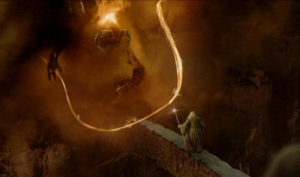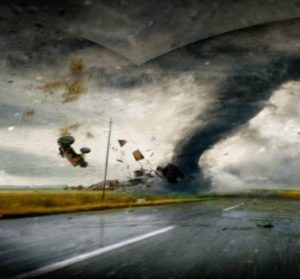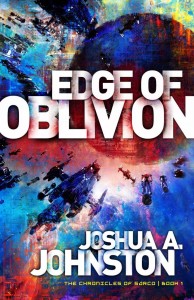Among the questions I’ve been asked for my debut novel, Edge of Oblivion, one of the most common relates to Malum, the planet-sized antagonist introduced at the outset of the book.
“What was your inspiration?” I’ve been asked.
Let’s talk.
 Now, the general idea of a Big Evil has a long and storied history, from the three antagonists of Beowulf to the Balrog of Lord of the Rings; from Goliath of the Old Testament to Japanese monster films like Godzilla. Big Evils are terrifying in large part because they are … well, massive. Few Star Wars fans will forget the first time they heard Obi-Wan Kenobi say, “That’s no moon,” right as the Millenium Falcon crosses paths with the first Death Star. Few Star Trek fans will forget the season finale of Season 3 of Star Trek: The Next Generation, when Jean-Luc Picard sends word to Starfleet that they have engaged the Borg.
Now, the general idea of a Big Evil has a long and storied history, from the three antagonists of Beowulf to the Balrog of Lord of the Rings; from Goliath of the Old Testament to Japanese monster films like Godzilla. Big Evils are terrifying in large part because they are … well, massive. Few Star Wars fans will forget the first time they heard Obi-Wan Kenobi say, “That’s no moon,” right as the Millenium Falcon crosses paths with the first Death Star. Few Star Trek fans will forget the season finale of Season 3 of Star Trek: The Next Generation, when Jean-Luc Picard sends word to Starfleet that they have engaged the Borg.
One subset of the Big Evil that has long fascinated me is what I refer to as the Big Faceless Evil. Whereas the Big Evil usually has some sort of discernible motivation — Balrog is a primal beast, the Borg are malicious assimilators — the Big Faceless Evil is distinguished by motives that are (at least for a time) far less clear. In fact, I think this mystery serves to elevate the terror factor of the evil in question, especially if the protagonists can’t figure out what drives the thing.
 My earliest exposure to the so-called Big Faceless Evil came in the form of the Doomsday Machine, a massive (and rather ridiculous-looking) antagonist featured during the second season of the original 1960s TV series Star Trek. In the episode, the Enterprise stumbles upon a derelict Starfleet vessel in a system whose planets have been obliterated. The ensuing drama pits James T. Kirk and his crew in a life-and-death struggle with a planet-killer. (Complicating matters is the fact that the lone survivor of the derelict ship, Commodore Matt Decker, develops a Captain Ahab complex that nearly destroys the Enterprise.)
My earliest exposure to the so-called Big Faceless Evil came in the form of the Doomsday Machine, a massive (and rather ridiculous-looking) antagonist featured during the second season of the original 1960s TV series Star Trek. In the episode, the Enterprise stumbles upon a derelict Starfleet vessel in a system whose planets have been obliterated. The ensuing drama pits James T. Kirk and his crew in a life-and-death struggle with a planet-killer. (Complicating matters is the fact that the lone survivor of the derelict ship, Commodore Matt Decker, develops a Captain Ahab complex that nearly destroys the Enterprise.)
So you have, in the Doomsday Machine, this huge, seemingly unstoppable machine that had no discernible motive. In fact, Captain Kirk even speculates in the episode that perhaps it was a machine whose purpose had long ago been lost. In the end, all we know it is that this thing is big, dangerous, and without any form of personality or programming which might be understood, bargained with, or otherwise tricked. It is a singular, quintessential destroyer.
 I’ve seen this archetype, to varying degrees, reappear in other speculative contexts. In some cases, we never learn the motives of the Big Faceless Evil. In The NeverEnding Story, for example, the realm of Fantasia is devoured by a noncorporeal menace known only as The Nothing. It is no coincidence that The Nothing is much like a force of nature, as forces of nature make for interesting Big Faceless Evils: tornadoes (Twister), volcanoes (Volcano), fire (Backdraft), and, of course, giant asteroids (Armageddon, Deep Impact).
I’ve seen this archetype, to varying degrees, reappear in other speculative contexts. In some cases, we never learn the motives of the Big Faceless Evil. In The NeverEnding Story, for example, the realm of Fantasia is devoured by a noncorporeal menace known only as The Nothing. It is no coincidence that The Nothing is much like a force of nature, as forces of nature make for interesting Big Faceless Evils: tornadoes (Twister), volcanoes (Volcano), fire (Backdraft), and, of course, giant asteroids (Armageddon, Deep Impact).
In many films, what starts out as a Big Faceless Evil becomes only understandable later on. The antagonists commanding the massive ships of Stargate and Independence Day are shrouded in mystery for much (but not all) of their respective films. The same goes for V’Ger and Unicron, the ship- and planet-destroying monstrosities of Star Trek: The Motion Picture and Transformers: The Movie. In many cases — in fact, with all of the aforementioned cases save V’Ger and, to a lesser extent, the Borg — any understanding of the Big Evil is tempered by the realization that, even if the Big Evil operates on some rational framework, that the Big Evil can nevertheless not be reasoned with. The Big Evil is distinctive in that it seeks to destroy, and the only way to thwart that destruction is to destroy the destroyer.
That brings us back to Malum, the Big Evil I’ve created for my debut novel. Is Malum a Big Faceless Evil that has no intrinsic motivation other than the impulse to destroy, or does Malum have a reason, a purpose behind that which it does?
us back to Malum, the Big Evil I’ve created for my debut novel. Is Malum a Big Faceless Evil that has no intrinsic motivation other than the impulse to destroy, or does Malum have a reason, a purpose behind that which it does?
To answer that, you’ll have to read the book.




